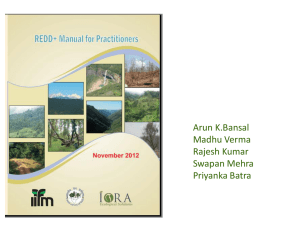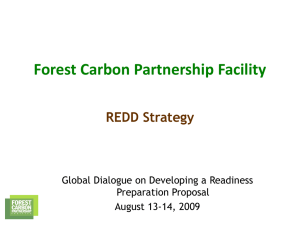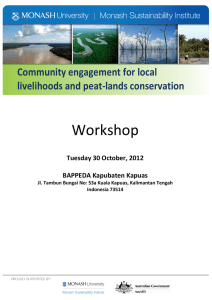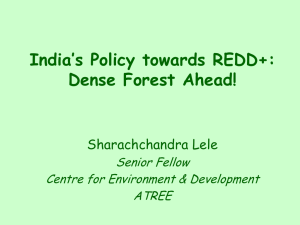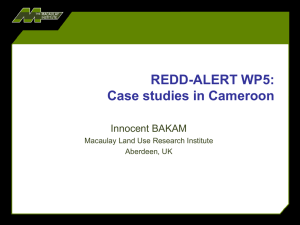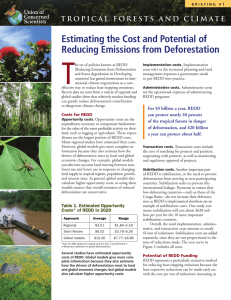countries with high deforestation. It would
advertisement
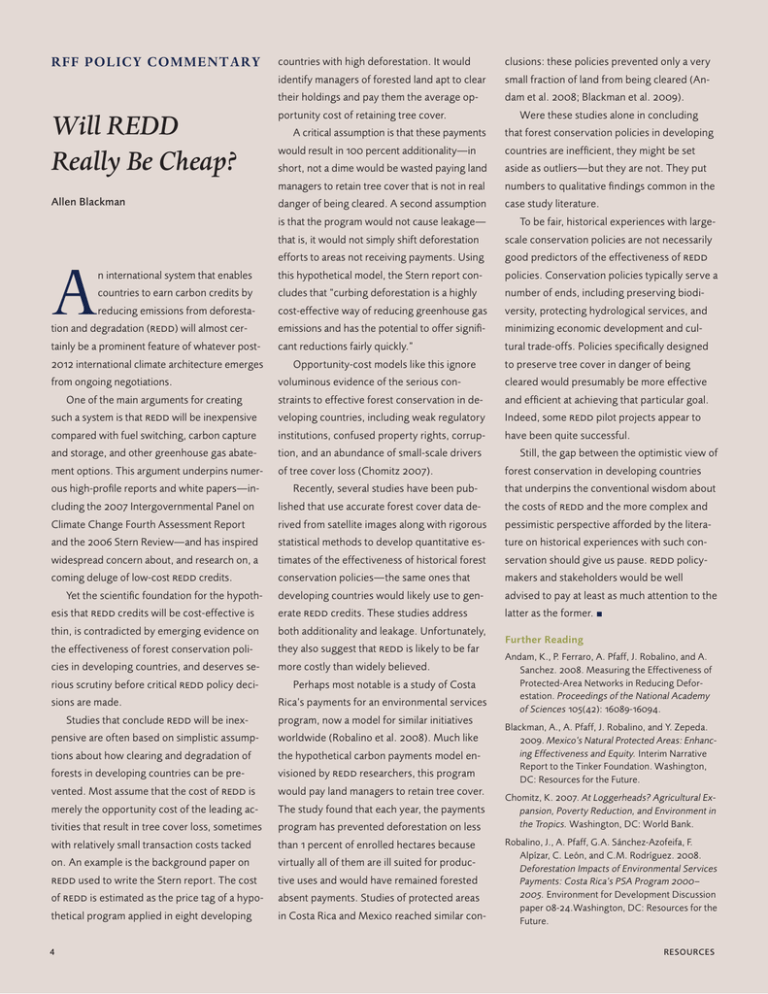
RFF POLICY COMMENTARY Will REDD Really Be Cheap? Allen Blackman A n international system that enables countries to earn carbon credits by reducing emissions from deforesta- tion and degradation (redd) will almost certainly be a prominent feature of whatever post2012 international climate architecture emerges from ongoing negotiations. One of the main arguments for creating such a system is that redd will be inexpensive compared with fuel switching, carbon capture and storage, and other greenhouse gas abate- ment options. This argument underpins numerous high-profile reports and white papers—including the 2007 Intergovernmental Panel on Climate Change Fourth Assessment Report and the 2006 Stern Review—and has inspired widespread concern about, and research on, a coming deluge of low-cost redd credits. Yet the scientific foundation for the hypothesis that redd credits will be cost-effective is thin, is contradicted by emerging evidence on the effectiveness of forest conservation policies in developing countries, and deserves serious scrutiny before critical redd policy decisions are made. Studies that conclude redd will be inexpensive are often based on simplistic assumptions about how clearing and degradation of forests in developing countries can be prevented. Most assume that the cost of redd is merely the opportunity cost of the leading activities that result in tree cover loss, sometimes with relatively small transaction costs tacked on. An example is the background paper on redd used to write the Stern report. The cost of redd is estimated as the price tag of a hypothetical program applied in eight developing 4 countries with high deforestation. It would identify managers of forested land apt to clear clusions: these policies prevented only a very small fraction of land from being cleared (An- their holdings and pay them the average op- dam et al. 2008; Blackman et al. 2009). Were these studies alone in concluding portunity cost of retaining tree cover. A critical assumption is that these payments would result in 100 percent additionality—in short, not a dime would be wasted paying land managers to retain tree cover that is not in real danger of being cleared. A second assumption is that the program would not cause leakage— that is, it would not simply shift deforestation efforts to areas not receiving payments. Using this hypothetical model, the Stern report concludes that “curbing deforestation is a highly cost-effective way of reducing greenhouse gas emissions and has the potential to offer significant reductions fairly quickly.” Opportunity-cost models like this ignore voluminous evidence of the serious constraints to effective forest conservation in developing countries, including weak regulatory institutions, confused property rights, corruption, and an abundance of small-scale drivers of tree cover loss (Chomitz 2007). Recently, several studies have been published that use accurate forest cover data derived from satellite images along with rigorous statistical methods to develop quantitative estimates of the effectiveness of historical forest conservation policies—the same ones that developing countries would likely use to generate redd credits. These studies address both additionality and leakage. Unfortunately, they also suggest that redd is likely to be far more costly than widely believed. Perhaps most notable is a study of Costa Rica’s payments for an environmental services program, now a model for similar initiatives worldwide (Robalino et al. 2008). Much like the hypothetical carbon payments model envisioned by redd researchers, this program would pay land managers to retain tree cover. The study found that each year, the payments program has prevented deforestation on less than 1 percent of enrolled hectares because virtually all of them are ill suited for productive uses and would have remained forested absent payments. Studies of protected areas in Costa Rica and Mexico reached similar con- that forest conservation policies in developing countries are inefficient, they might be set aside as outliers—but they are not. They put numbers to qualitative findings common in the case study literature. To be fair, historical experiences with largescale conservation policies are not necessarily good predictors of the effectiveness of redd policies. Conservation policies typically serve a number of ends, including preserving biodiversity, protecting hydrological services, and minimizing economic development and cultural trade-offs. Policies specifically designed to preserve tree cover in danger of being cleared would presumably be more effective and efficient at achieving that particular goal. Indeed, some redd pilot projects appear to have been quite successful. Still, the gap between the optimistic view of forest conservation in developing countries that underpins the conventional wisdom about the costs of redd and the more complex and pessimistic perspective afforded by the literature on historical experiences with such conservation should give us pause. redd policymakers and stakeholders would be well advised to pay at least as much attention to the latter as the former. ∫ Further Reading Andam, K., P. Ferraro, A. Pfaff, J. Robalino, and A. Sanchez. 2008. Measuring the Effectiveness of Protected-Area Networks in Reducing Deforestation. Proceedings of the National Academy of Sciences 105(42): 16089-16094. Blackman, A., A. Pfaff, J. Robalino, and Y. Zepeda. 2009. Mexico’s Natural Protected Areas: Enhancing Effectiveness and Equity. Interim Narrative Report to the Tinker Foundation. Washington, DC: Resources for the Future. Chomitz, K. 2007. At Loggerheads? Agricultural Expansion, Poverty Reduction, and Environment in the Tropics. Washington, DC: World Bank. Robalino, J., A. Pfaff, G.A. Sánchez-Azofeifa, F. Alpízar, C. León, and C.M. Rodríguez. 2008. Deforestation Impacts of Environmental Services Payments: Costa Rica’s PSA Program 2000– 2005. Environment for Development Discussion paper 08-24.Washington, DC: Resources for the Future. RESOURCES


